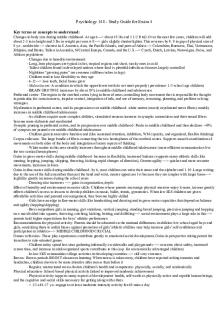Bio 220 Exam 4 Study Guide PDF

| Title | Bio 220 Exam 4 Study Guide |
|---|---|
| Course | Environmental Science |
| Institution | Grand Canyon University |
| Pages | 3 |
| File Size | 86.3 KB |
| File Type | |
| Total Downloads | 35 |
| Total Views | 151 |
Summary
Stud guide to prepare for exam 4 of Bio 220....
Description
Water Use and Management 1. The Hydrologic Cycle Water evaporates from moist surfaces (oceans/rivers/lakes/groundwater), falls as rain or snow, passes through living organisms and returns to the ocean. Driven by solar energy Three principal factors control global water deficits and surpluses: o Global atmospheric circulation o Proximity to water sources/reservoirs o Topography 2. Rain Shadow effect cool, dry air descends from the mountaintop down the other side of the mountain creating dry areas with very little precipitation 3. Role of oceans as a water source Holds 97% of the total water on the planet and produces over half of the world's oxygen and absorbs 50 times more carbon dioxide than our atmosphere. Biomass, regulates temp/climate by Redistributing cold and warm water around the earth 4. Where water is found: o Glaciers/icecaps/snowfields (2.4% E, 87% freshwater) o Groundwater 12% F o Rivers/lakes/wetlands o Atmosphere (rain) o Oceans 97.6% E Infiltration - process of water percolating through soil and into fractures and permeable rocks Layers of infiltration: Zone of aeration - upper soil layers that hold both air and water Zone of saturation - lower soil layers where all spaces are filled with water Water table - top of zone of saturation 5. Withdrawal -total amount of water removed from a water body. 6. Consumption -loss of water due to evaporation, absorption, or contamination Water Pollution 1. Point Sources - discharge pollution from specific locations can be avoided o Factories, power plants, drainpipes 2. Nonpoint Sources - scattered or diffuse, having no specific location of discharge (coming from many locations) difficult to regulate Surface runoff 3. Atmospheric Deposition Contaminants carried by air current and precipitated into watersheds or directly onto surface waters as rain, snow, or dry particles 4. Infectious Agents
pathogenic organisms such as viruses, bacteria, fungi, protozoa that cause disease/infection Main source of waterborne pathogens is improperly treated human waste 5. Biochemical Oxygen Demand - amount of dissolved oxygen consumed by aquatic microorganisms. Used as a test for organic waste contamination from sewage, paper pulp, and food waste. >6ppm-aquatuc life ...
Similar Free PDFs

Bio 220 Exam 4 Study Guide
- 3 Pages

BIO 1406 Exam 4 Study Guide
- 73 Pages

Bio Exam 2 study guide
- 8 Pages

BIO 220 Topic 4 Assignment
- 5 Pages

Bio exam 3 study guide
- 10 Pages

BIO TEST 4 STUDY GUIDE
- 9 Pages

Kin 220 Exam 1 Study Guide
- 4 Pages

BIO 220 Exam 1 Notes
- 3 Pages

Micro 220 Exam 1 study guide 1
- 2 Pages

Exam 4 Study Guide
- 22 Pages

EXAM 4 study guide
- 15 Pages

Study Guide Exam 4
- 8 Pages

Exam 4 Study Guide
- 4 Pages

Study guide exam 4
- 6 Pages

Exam 4 Study Guide
- 5 Pages

BIO Exam 3 - Exam 3 study guide
- 10 Pages
Popular Institutions
- Tinajero National High School - Annex
- Politeknik Caltex Riau
- Yokohama City University
- SGT University
- University of Al-Qadisiyah
- Divine Word College of Vigan
- Techniek College Rotterdam
- Universidade de Santiago
- Universiti Teknologi MARA Cawangan Johor Kampus Pasir Gudang
- Poltekkes Kemenkes Yogyakarta
- Baguio City National High School
- Colegio san marcos
- preparatoria uno
- Centro de Bachillerato Tecnológico Industrial y de Servicios No. 107
- Dalian Maritime University
- Quang Trung Secondary School
- Colegio Tecnológico en Informática
- Corporación Regional de Educación Superior
- Grupo CEDVA
- Dar Al Uloom University
- Centro de Estudios Preuniversitarios de la Universidad Nacional de Ingeniería
- 上智大学
- Aakash International School, Nuna Majara
- San Felipe Neri Catholic School
- Kang Chiao International School - New Taipei City
- Misamis Occidental National High School
- Institución Educativa Escuela Normal Juan Ladrilleros
- Kolehiyo ng Pantukan
- Batanes State College
- Instituto Continental
- Sekolah Menengah Kejuruan Kesehatan Kaltara (Tarakan)
- Colegio de La Inmaculada Concepcion - Cebu